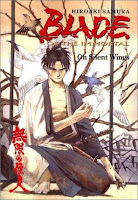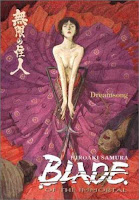 Creator: Yumiko Shirai
Creator: Yumiko Shirai
U.S. publisher: One Peace Books
ISBN: 9781935548034
Released: September 2010
Original release: 2008
Awards: Japan Media Arts Award
When the 2010 English translation of Tenken by Yumiko Shirai was brought to my attention, I had a sneaking suspicion that I already knew about the manga. And indeed, after a brief investigation, I realized that I had previously seen it listed as the 2007 winner of the Japan Media Arts Award Encouragement Prize under the title Tenken-sai. At that point, I had no idea that an English edition was in the works. In fact, I didn’t really know anything about Tenken except that it had won the award. I wasn’t familiar with the English publisher, One Peace Books, either. But when I had the chance to sample the first few pages of the book and caught sight of the artwork, I knew that I needed to read the manga if for no other reason than the gorgeous illustrations.
Each year, towns across the country celebrate the Tenken festival and every fifty years the celebration is particularly large and involved. For the people who are still working to rebuild after the devastating Dirty War, the festival and the legend of Princess Kushinada is a source of hope. Manaka is the boss of the Sakamoto construction group and unknowingly hired a runaway who had been chosen to be the Princess Kushinada for a nearby mountain district’s festival. Kishima is returned against her will and Manaka chases after her despite her and other’s protests. Manaka soon discovers the terrible origins and meaning behind the Tenken festival’s traditions and Princess Kushinada’s sacrifice. He is determined to do everything he possibly can to save the woman he has come to love from her fate.
Shirai’s art in Tenken is simply stunning. Although I am unsure of the actual techniques used, I would describe the artwork as semi-realistic illustration done in ink and watercolor, but using only blacks and greys. The effect can be breathtaking. It’s not a style that I’ve seen used in manga or other comics very often, but it’s gorgeous. On occasion the action can be somewhat difficult to follow, almost as if there was a panel missing from the sequence, while at other times only a glance is needed to tell exactly what is going on. At first, I was unsure of what time period the story was set but it is soon revealed that these people are living in a post-apocalyptic society. Shirai’s attention to background details, like the ever present wind turbines and general sense of ruin, help to emphasize this. While beautiful, the artwork, like the story, can also be rather bleak but it is not without hope.
The Tenken festival is a very interesting celebration with a complex history. Just how complex isn’t revealed until the final chapters where reality, dreams, myths and legends all twist, turn, and entwine together, making it hard to say where one starts and the others end. Admittedly, it can be a bit difficult to follow and understand at times, but I found the syncretism between science and religion to be marvelous. For good or for ill, beliefs and traditions can be a powerful force. Manaka, who I would describe as a nonbeliever for much of the book, must confront these forces head on and come to the realization that there is some truth behind the superstitions. I thoroughly enjoyed Tenken, both the manga’s art and it’s story, but particularly the intersection of the divine and the mundane in a post-apocalyptic setting. One of my few complaints actually has nothing to do with Shirai’s work—One Peace’s English edition desperately needs a copy-editor. While the errors can be terribly distracting, the strength of the artwork and the story’s depth mostly make up for it. I’m very glad that I picked up this manga and can see myself enjoying it again.




